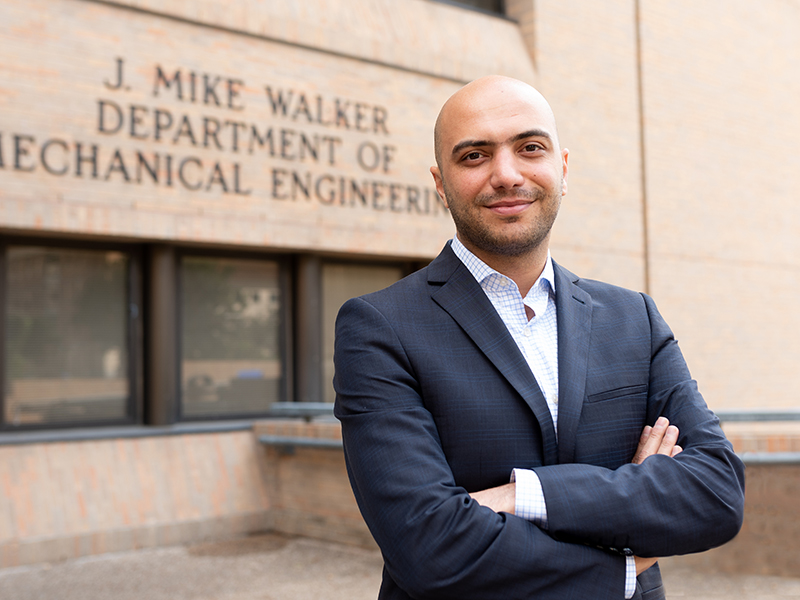Back to Faculty Directory

farshid.alambeigi@austin.utexas.edu
Office Location: AHG 2.320
Farshid Alambeigi
Associate Professor
Leland Barclay Fellowship in Engineering
Department Research Areas
Advanced Design and Manufacturing
Biomechanical and Biomedicine Engineering
Robotics and Intelligent Mechanical Systems
Director of ARTS Lab
Dr. Farshid Alambeigi joined the Walker Department of Mechanical Engineering at the University of Texas at Austin in August 2019. He is also one of the core faculties of the Texas Robotics. Dr. Alambeigi received his Ph.D. in Mechanical Engineering from the Johns Hopkins University, in 2019. He also holds an M.Sc. degree (2017) in Robotics from the Johns Hopkins University. In summer of 2018, Dr. Alambeigi received the 2019 SIEBEL Scholarship because of the academic excellence and demonstrated leadership. In 2020, Dr. Alambeigi received the NIH NIBIB Trailblazer Career Award to develop novel flexible implants and robots for minimally invasive spinal fixation surgery. In 2022, he also received the prestigious NIH Director’s New Innovator Award to develop an in vivo bioprinting surgical robotic system for treatment of volumetric muscle loss.
At The University of Texas at Austin, Dr. Alambeigi directs the Advanced Robotic Technologies for Surgery (ARTS) Lab. Dr. Alambeigi’s research focuses on developing high dexterity and situationally aware continuum manipulators, soft robots, and appropriate instruments especially designed for less/minimally invasive treatment of various medical applications. Utilizing these novel surgical instruments together with intelligent control algorithms, the ARTS Lab in collaboration with the UT Dell Medical School will work toward digital surgery and partnering dexterous intelligent robots with surgeons. Ultimately, our goal is to augment the clinicians’ skills and quality of the surgery to further improve patient’s safety.
Recent Publications
- O. C. Kara, N. Venkatayogi, N. Ikoma, F. Alambeigi, “A Reliable and Sensitive Framework for Simultaneous Type and Stage Detection of Colorectal Cancer Polyps”, Annals of Biomedical Engineering (ABME), January 2023.
- Y. Liu, T. G. Mohanraj, R. Rajebi, L. Zhou, and F. Alambeigi, “A Multiphysical Analytical Modeling Framework of Magnetically Steerable Robotic Catheter for Treatment of Peripheral Artery Disease,” IEEE/ASME Transactions on Mechatronics (TMECH), May 2022. DOI: 10.1109/TMECH.2022.3174520.
- Pettinger, F. Alambeigi*, M. Pryor*, “A Versatile Affordance Modeling Framework Using Screw Primitives to Increase Autonomy during Manipulation Contact Tasks”, IEEE Robotics and Automation Letters (RAL), 7(3), pp.7224-7231, 2022. DOI: 10.1109/LRA.2022.3181732
- J. Zhu, A. Cherubini, C. Dune, D. Navarro-Alarcon, F. Alambeigi, D. Berenson, F. Ficuciello, K. Harada, J. Kober, X. Li, J. Pan, W. Yuan, and M. Gienger, “Challenges and Outlook in Robotic Manipulation of Deformable Objects,” IEEE Robotics and Automation Magazine (RAM), In Press, pp. 2-12, Feb. 2022. DOI: 10.1109/MRA.2022.3147415
- Y. Liu and F. Alambeigi, “Impact of Generic Tendon Routing on Tension Loss of Tendon-Driven Continuum Manipulators,” IEEE Robotics and Automation Letters (RAL), 7(2), pp.3624-3631, Feb. 2022. DOI: 10.1109/LRA.2022.3147903
- Y. Liu, U. Yoo, S. Ha, S. F. Atashzar, and F. Alambeigi,” Influence of Antagonistic Tensions on Distributed Friction Forces of Multi-Segment Tendon-Driven Continuum Manipulators with Irregular Geometry,” IEEE/ASME Transactions on Mechatronics (TMECH), pp. 1-11, October 2021. DOI: 10.1109/TMECH.2021.3112580
- F. Alambeigi, S. Aghajani Pedram, J. Speyer, I. Iordachita, R. H. Taylor, and M. Armand, “SCADE: Simultaneous Sensor Calibration and Deformation Estimation of FBG-Equipped Unmodeled Continuum Manipulators“, IEEE Transaction on Robotics (TRO), October 2019.
- F. Alambeigi, M. Bakhtiarinejad, S. Sefaty, R. Hegeman, I. Iordachita, H. Khanuja, and M. Armand, "On the Use of a Continuum Manipulator and a Bendable Medical Screw for Minimally-Invasive Interventions in Orthopedic Surgery", IEEE Transaction on Medical Robotics and Bionics (TMRB), January 2019.
- F. Alambeigi, Z. Wang, Y. H. Liu, R. H. Taylor, and M. Armand, "Toward Autonomous Needle Insertion Using Collaborative Manipulation of Unmodeled Deformable Tissues," Annals of Biomedical Engineering, March 2018.
- F. Alambeigi, Wang Y, Sefati S, Gao C, Murphy RJ, Iordachita I, Taylor RH, Khanuja H, Armand M. “A Curved-Drilling Approach in Core Decompression of the Femoral Head Osteonecrosis using a Continuum Manipulator,” IEEE Robotics and Automation Letters, 2017.
- F. Alambeigi, Z. Wang, R. Hegeman, Y. H. Liu, R. H. Taylor, and M. Armand, ”A Robust Data-Driven Approach for Online Learning and Manipulation of Unmodeled 3-D Heterogeneous Compliant Objects,” IEEE Robotics and Automation Letters and IROS 2018 conference, June 2018.






